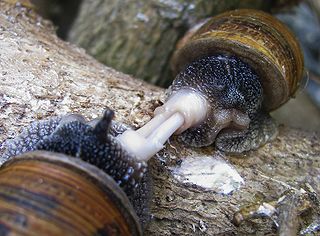
Ernst Walter Mayr was one of the 20th century's leading evolutionary biologists. He was also a renowned taxonomist, tropical explorer, ornithologist, philosopher of biology, and historian of science. His work contributed to the conceptual revolution that led to the modern evolutionary synthesis of Mendelian genetics, systematics, and Darwinian evolution, and to the development of the biological species concept.

Vascular plants, also known as Tracheophyta, form a large group of plants that are defined as land plants with lignified tissues for conducting water and minerals throughout the plant. They also have a specialized non-lignified tissue to conduct products of photosynthesis. Vascular plants include the clubmosses, horsetails, ferns, gymnosperms and angiosperms. Scientific names for the group include Tracheophyta, Tracheobionta and Equisetopsida sensu lato. Some early land plants had less developed vascular tissue; the term eutracheophyte has been used for all other vascular plants.

Moray eels, or Muraenidae, are a family of eels whose members are found worldwide. There are approximately 200 species in 15 genera which are almost exclusively marine, but several species are regularly seen in brackish water, and a few are found in fresh water.

Galactokinase is an enzyme (phosphotransferase) that facilitates the phosphorylation of α-D-galactose to galactose 1-phosphate at the expense of one molecule of ATP. Galactokinase catalyzes the second step of the Leloir pathway, a metabolic pathway found in most organisms for the catabolism of β-D-galactose to glucose 1-phosphate. First isolated from mammalian liver, galactokinase has been studied extensively in yeast, archaea, plants, and humans.

Eureptilia is one of the two major clades of the Sauropsida, the other being Parareptilia. Eureptilia includes not only all Diapsids, but also a number of primitive Permo-Carboniferous forms previously classified under the Anapsida, in the old order "Cotylosauria".

The pollan or Irish pollan is a freshwater whitefish known only from five Irish lakes, Lough Neagh, Lower Lough Erne, Lough Ree, Lough Derg, and Lough Allen. The Irish pollan faces competition from introduced species such as pike, roach, and zebra mussel and the populations rely on restocking for survival.

Nepenthes gracillima is a highland Nepenthes pitcher plant species, native to Peninsular Malaysia.
Nepenthes lavicola is a tropical pitcher plant species endemic to the Geureudong Massif of Aceh, northern Sumatra, where it grows at 2000–2600 m above sea level. It is thought to be most closely related to N. singalana and N. spectabilis.

Human accelerated regions (HARs), first described in August 2006, are a set of 49 segments of the human genome that are conserved throughout vertebrate evolution but are strikingly different in humans. They are named according to their degree of difference between humans and chimpanzees. Found by scanning through genomic databases of multiple species, some of these highly mutated areas may contribute to human-specific traits. Others may represent loss of functional mutations, possibly due to the action of biased gene conversion rather than adaptive evolution.

In molecular biology, the small nucleolar RNAs SNORD106 and SNORD12 are two related snoRNAs which belongs to the C/D class of small nucleolar RNAs (snoRNAs). Both contain the conserved C (UGAUGA) and D (CUGA) box sequence motifs
Donald Irving Williamson was a British planktologist and carcinologist.

Protostegidae is a family of extinct marine turtles that lived during the Cretaceous period. The family includes some of the largest sea turtles that ever existed. The largest, Archelon, had a head one metre (39 in) long. Like most sea turtles, they had flattened bodies and flippers for front appendages; protostegids had minimal shells like leatherback turtles of modern times.

In reproductive biology, a hermaphrodite is an organism that has both kinds of reproductive organs and can produce both gametes associated with male and female sexes.
In biology, a species is the basic unit of classification and a taxonomic rank of an organism, as well as a unit of biodiversity. A species is often defined as the largest group of organisms in which any two individuals of the appropriate sexes or mating types can produce fertile offspring, typically by sexual reproduction. Other ways of defining species include their karyotype, DNA sequence, morphology, behaviour or ecological niche. In addition, paleontologists use the concept of the chronospecies since fossil reproduction cannot be examined.
Dogger Bank itch is a cutaneous condition characterized by a long-lasting dermatitis caused by exposure to the sea chervil, Alcyonidium diaphanum, a bryozoan. The disease, common in fishermen who work in the North Sea, has been recognized by the Danish Workman's Compensation Act since 1939.

Goniodoris nodosa is a species of sea slug, a dorid nudibranch, a marine gastropod mollusc in the family Goniodorididae.

Onchidoris proxima is a species of sea slug, a dorid nudibranch, a shell-less marine gastropod mollusc in the family Onchidorididae. This species is found in the northeastern and northwestern parts of the Atlantic Ocean. It is also reported from the northeastern Pacific Ocean. Previously in the genus Adalaria this species was moved to Onchidoris as a result of a molecular phylogeny study.

Alcyonidium is a genus of bryozoans in the order Ctenostomatida.

Emma Caroline Teeling is an Irish zoologist, geneticist and genomicist, who specialises in the phylogenetics and genomics of bats. Her work includes understanding of the bat genome and study of how insights from other mammals such as bats might contribute to better understanding and management of ageing and a number of conditions, including deafness and blindness, in humans. She is the co-founder of the Bat1K project to map the genomes of all species of bat. She is also concerned with understanding of the places of bats in the environment and how to conserve their ecosystem.














